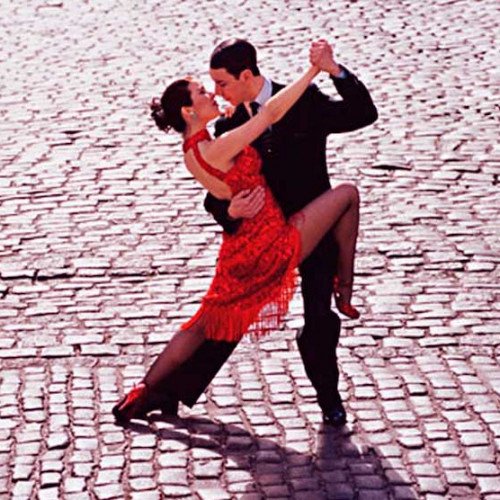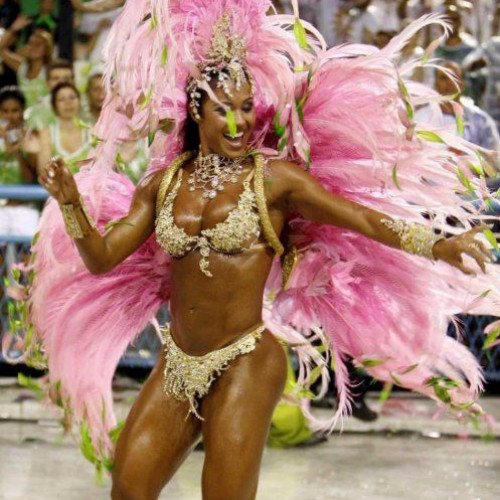Latin American musical genres

Tango
Tango is a style of music in 2 4 or 4 4 time that originated among European immigrant populations of Argentina and Uruguay (collectively, the "Rioplatenses").[1] It is traditionally played on a solo guitar, guitar duo, or an ensemble, known as the orquesta típica, which includes at least two violins, flute, piano, double bass, and at least two bandoneóns. Sometimes guitars and a clarinet join the ensemble. Tango may be purely instrumental or may include a vocalist. Tango music and dance have become popular throughout the world. Even though present forms of tango developed in Argentina and Uruguay from the mid-19th century, there are records of 19th and early 20th-century tango styles in Cuba and Spain,[3] while there is a flamenco tango dance that may share a common ancestor in a minuet-style European dance.[4] All sources stress the influence of African communities and their rhythms, while the instruments and techniques brought in by European immigrants in the 20th century played a major role in the style's final definition, relating it to the salon music styles to which tango would contribute back at a later stage. Angel Villoldo's 1903 tango "El Choclo" was first recorded no later than 1906 in Philadelphia.[5] Villoldo himself recorded it in Paris (possibly in April 1908, with the Orchestre Tzigane du Restaurant du Rat Mort),[6] as there were no recording studios in Argentina at the time. Early tango was played by immigrants in Buenos Aires, then later in Montevideo.[7][8][9] The first generation of tango players from Buenos Aires was called "Guardia Vieja" (the Old Guard). It took time to move into wider circles; in the early 20th century, it was the favorite music of thugs and gangsters who visited brothels,[10] in a city with 100,000 more men than women (in 1914). The complex dances that arose from such rich music reflect how the men would practice the dance in groups, demonstrating male sexuality and causing a blending of emotion and aggressiveness. The music was played on portable instruments: flute, guitar, and violin trios, with bandoneón arriving at the end of the 19th century. The organito, a portable player-organ, broadened the popularity of certain songs. Eduardo Arolas was the major driver of the bandoneón's popularization, with Vicente Greco soon standardizing the tango sextet as consisting of piano, double bass, two violins, and two bandoneóns.
Statistics for this Xoptio

Samba
Samba (Portuguese pronunciation: [ˈsɐ̃bɐ] (About this soundlisten)), also known as samba urbano carioca (Urban Carioca Samba)[1][2] or simply samba carioca (Carioca Samba)[3][4] is a Brazilian music genre that originated in the Afro-Brazilian communities of Rio de Janeiro in the early 20th century.[5][6] Having its roots in the cultural expression of West Africa and in Brazilian folk traditions,[7] especially those linked to the primitive rural samba[5] of the colonial and imperial periods,[8] is considered one of the most important cultural phenomena in Brazil[9] and one of the country symbols.[10][11][12][13] Present in the Portuguese language at least since the 19th century, the word "samba" was originally used to designate a "popular dance".[14] Over time, its meaning has been extended to a "batuque-like circle dance", a dance style, and also to a "music genre".[14][15] This process of establishing itself as a musical genre began in the 1910s[16] and it had its inaugural landmark in the song "Pelo Telefone", launched in 1917.[17][18] Despite being identified by its creators, the public, and the Brazilian music industry as "samba", this pioneering style was much more connected from the rhythmic and instrumental point of view to maxixe than to samba itself.[16][19][20] Samba was modernly structured as a musical genre only in the late 1920s[16][19][21] from the neighborhood of Estácio and soon extended to Oswaldo Cruz and other parts of Rio through its commuter rail.[22] Today synonymous with the rhythm of samba,[23] this new samba brought innovations in rhythm, melody and also in thematic aspects.[24] Its rhythmic change based on a new percussive instrumental pattern resulted in a more "batucado" and syncopated style[25] – as opposed to the inaugural "samba-maxixe"[26] – notably characterized by a faster tempo, longer notes and a characterized cadence far beyond the simple ones palms used so far.[27][28] Also the "Estácio paradigm" innovated in the formatting of samba as a song, with its musical organization in first and second parts in both melody and lyrics.[20][29][30] In this way, the sambistas of Estácio created, structured and redefined the Urban Carioca Samba as a genre in a modern and finished way.[20] In this process of establishment as an urban and modern musical expression, the Carioca Samba had the decisive role of samba schools, responsible for defining and legitimizing definitively the aesthetic bases of rhythm,[31] and radio broadcasting, which greatly contributed to the diffusion and popularization of the genre and its song singers.[32] Thus, samba has achieved major projection throughout Brazil and has become one of the main symbols of Brazilian national identity.[nb 1][nb 2][35] Once criminalized and rejected for its Afro-Brazilian origins, and definitely working-class music in its mythic origins, the genre has also received support from members of the upper classes and the country's cultural elite.